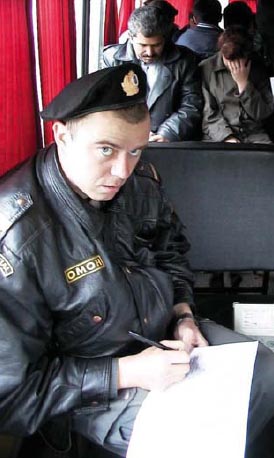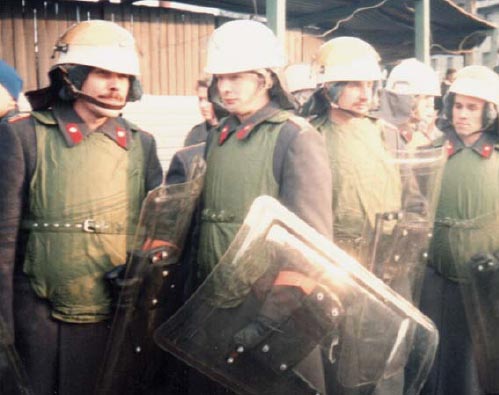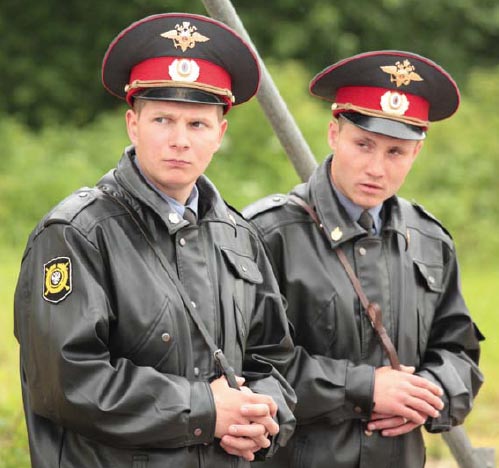
Russia has a tradition of violent politics, in which internal security forces are often crucial: as the suppressors of revolution, the eyes and strong right hands of the state, and the agents of factional politics – both as king-makers, and king-breakers. This is an age-old tradition, dating back to the custom of every medieval Rus’ prince to maintain his druzhina or armed personal retinue, as well as to the streltsy (“shooters”) raised by Ivan the Terrible in the 16th century. These latter were simultaneously a war-fighting force, the palace guard, the Moscow police, and even the fire brigade.1 Later, the tsars would not only form the uniformed Special Corps of Gendarmes to suppress dissent, but would also rely on regiments of Cossacks to put down riots and rebellions. The Bolshevik Revolution of 1917 did not end the tendency of Russia’s rulers to raise and retain numerous, competing internal security forces; if anything, leaders became all the more concerned about the need to maintain a balance of power between rival praetorians in order to exclude the danger of coups. The Bolshevik leader Lenin was initially guarded by a special unit of Latvian riflemen, but in due course the Red Army, political police, and regular police would form a stable (if mutually suspicious) security structure in the capital.

Police junior NCO processing prisoners inside a bus after a mass arrest in Chechnya in 1999; his black beret and the right chest tab identify OMON. These riot units affected the black leather jacket for most of the 1990s and into the 2000s, but it is now rarely seen in large cities and is, indeed, something of the mark of a provincial cop. The English-language shoulder title, probably “TEAM SPECIAL,” is an affectation typical of the 1990s. (Northfoto/Shutterstock.com)
Russia’s paramilitary and security forces have always tended to be closer to the political leadership than the regular military. Indeed, their job was often to keep the soldiers in line – a technique perfected by Stalin, who unleashed the NKVD secret police on the Red Army in the purges of 1937. Their role has tended to be explicitly political, making them the instruments of the government (or powerful figures within it) rather than simple servants of any legal or constitutional order. Having been its most vicious defenders, however, it was, ironically, their actions – and inactions – that proved pivotal in the downfall of the Soviet Union. In August 1991, Communist Party hardliners launched a political coup against President Gorbachev during his absence from Moscow. However, the refusal of members of the KGB’s Alpha counterterrorist commando force to obey their orders and spearhead an attack on the parliamentary building used as a headquarters by maverick Russian leader Boris Yeltsin spelled the beginning of the end of the coup. In September 1993, however, after the dissolution of the USSR, security troops of the Ministry of Internal Affairs (MVD) would assault that same White House, this time on Yeltsin’s orders, to forcibly close down the parliament that was defying him.

The closing years of the USSR saw the Kremlin trying to adapt to a new age of public protests for which it had never seriously planned. These police, present at an antigovernment march in 1991, are equipped with firefighters’ helmets, clumsy body armor over their greatcoats, plastic shields that tended to buckle under impact, and rubber truncheons. Their main handicap, however, was that they had little real idea of what to do when public protests turned violent. (Author’s photo)
With the partition of the Soviet Union and the creation of an independent Russian Federation, President Yeltsin promised democratization and demilitarization, but his years in office (1991–99) proved to be a time of drift and disorder during which the security apparatus became increasingly important. In 1991, not counting the regular police, there had been more than 400,000 internal security troops and paramilitaries across the whole USSR – one for every 700 Soviet citizens, and one for every ten regular soldiers. By 1995 there were some 382,500 security and paramilitary troops in the Russian Federation alone, or one for every 392 citizens. The regular military was in a catastrophic state; while on paper it still had a strength of 1.9 million, there were fewer than a million actually at operational readiness. In other words, there was one security or paramilitary officer for every two or three truly deployable soldiers.
These security and paramilitary personnel may have been numerous, but they were not necessarily especially proficient. They were responsible for both blunders and brutality in the First Chechen War (1994–96), and have a distinctly mixed record in facing subsequent terrorist attacks. In part this reflects the need to do more with less, for while their duties were expanding their funding was shrinking. As a result, they suffered a hemorrhage of many of their most able officers into the private sector.
However, the rise of KGB veteran Vladimir Putin, President of Russia 2000–2008 and again since 2012, saw a revival in their fortunes. These agencies assumed a key role in the Second Chechen War (1999–2009), were increasingly lionized in the state-controlled media, and received steadily increasing budgets. Although Dmitry Medvedev was nominally president in the years 2008–12, Putin remained in charge behind the scenes as his powerful prime minister, and the security agencies have thus enjoyed more than a decade of expansion and generous funding.
Although some of these resources did trickle down to the regular police and paramilitary troops of the MVD, the disproportionate beneficiaries were the security services – above all the Federal Security Service (FSB), the main heirs to the KGB – and the numerous elite forces known by the umbrella term Spetsnaz. This term has been popularized mainly in connection with the Army’s commando units, but in fact it is simply a contraction of spetsialnogo naznacheniya, “of special purpose,” and is of more general application. The proliferation of such units in part reflects the increasingly complex challenges facing the country, from terrorism to organized crime. However, their growth has also been a product of the nature of Russian politics, as many agencies, often with overlapping and competing agendas, sought to assert their rights and roles. (For example, the struggle against drug-traffickers was a core responsibility of no fewer than four agencies – the MVD, the FSB, the Border Guards, and the Federal Narcotics Control Service – each with their own special forces.)
By the time of Putin’s return to the Kremlin in 2012 this pattern had been set, and none of the agencies looked willing to give up their spetsgruppy – their special forces groups. If anything, these continue to multiply, as new ones are established at local levels. Russia is, after all, the largest country in the world, comprising 83 separate constituent republics and regions, and spanning nine time zones. In such a country the ability to draw on local forces – familiar with conditions in their home regions, and, above all, based closer than several hours’ flight-time away – is often crucial. More to the point, as a growing proportion of Afghan heroin moves north through Russia, as insurgency spreads in the North Caucasus, and as the threat of political disorder grows, the Kremlin is likely to see its need for these elite security and paramilitary forces increase rather than diminish.

The uniform of the regular police in early 2012, before the issue of the more modern and less military design (see Plate A1). The red cap band and piping stand out against the dark gray and black of this spring/fall uniform. The Ministry of Internal Affairs (MVD) crest on the crown of the cap features the traditional Russian double-headed eagle, and the badge on the band has the Russian tricolor cockade – blue, white, and red, from edge to center – set in a wreath. The silver-gray central motif on the right-sleeve patch identifies the exact arm of service. (Lilyana Vynogradova/Shutterstock.com)
1 See Men-at-Arms 367, Medieval Russian Armies 1250–1500, and MAA 427, Armies of Ivan the Terrible